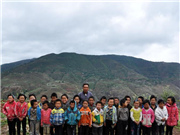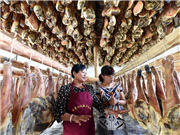

8) We will steadily move ahead with reforms of the rural and land system.
We will prudently carry out trial reforms concerning rural land requisition, the marketization of rural collective land designated for business-related construction, the system of land used for rural housing, and the rural collective property rights system. We will launch trials of allowing rural land-use rights to be used as collateral to borrow money, guide farmers in becoming shareholders of cooperatives and leading enterprises by contributing their land-use rights, and develop appropriately scaled, diversified farm operations. We will improve the system of unified registration of immovable property, carry out the trial of determining and registering water rights, and advance price reform of water used for agricultural purposes. We will fully deepen the comprehensive reform of supply and marketing cooperatives, and move faster to reform state forestry farms and areas, state farms built on reclaimed land, and the seed industry.
In addition, we also need to move ahead with institutional reforms in education, science, technology, culture, medical and health care, social management, and ecological progress.
3. Thoroughly implementing the strategy of opening up
We will act more quickly to make Chinese businesses more competitive in the international market, allow exports to effectively drive economic growth, and expand the scope and depth of opening up.
1) We will give impetus to the steady growth in foreign trade.
We will improve the system for joint payment of export rebates by the central and local governments. We will help cultivate brand names for export and overseas marketing networks. We will improve cross-border e-commerce, market purchases, integrated services for foreign trade, and other new trade models. We will give preferential credit to buyers of Chinese exports in order to stimulate the export of Chinese equipment, technology, and standards. We will improve policies that promote the trade in services, expand the export of services, and increase support for efforts to undertake services outsourced by other countries. We will adopt a more proactive import policy, expanding the import of advanced technology, key equipment, and important parts and components.
2) We will raise the utilization of foreign capital to a new level.
We will revise the Catalogue for the Guidance of Industries for Foreign Investment. We will encourage other parts of the country to make use of the experience gained in the China (Shanghai) Pilot Free Trade Zone, and move steadily forward with the building of pilot free trade zones in Guangdong, Tianjin, and Fujian. We will focus on opening the service sector and the general manufacturing sector wider to the outside world, carrying out trials to open up our financial sector, and revamping the model of managing foreign debt. We will explore the management model of pre-establishment national treatment (PENT) plus a negative list, and improve the system for security reviews of foreign investments. In 2015, foreign direct investment in China’s non-financial sectors is projected to reach US$120 billion, which is similar to last year.
3) We will raise the efficiency and quality of China’s outward investment.
We will move faster to build a system for providing financial services to outward investment, expand the channel for using foreign exchange reserves, and provide better financial services, information services, legal services, and consulate protection for Chinese enterprises investing overseas. With the focus on the construction of key and iconic projects, we will continue to encourage the building of overseas railways, ports, highways, and nuclear power projects; deepen cooperation on energy and resources with other countries; expand cooperation on equipment manufacturing, emerging industries, ecological conservation, and environmental protection; and increase the pace of China’s production capacity and equipment in “going global”. In 2015, China’s non-financial outward direct investment is estimated to come to US$113 billion, which is an increase of about 10%.
4) We will increase multilateral, bilateral, and regional economic cooperation.
We will put into practice the strategy of developing the Silk Road Economic Belt and the 21st Century Maritime Silk Road, and build the China-Pakistan Economic Corridor and the Bangladesh-China-India-Myanmar Economic Corridor. We will speed up infrastructure connectivity with our neighbors. We will upgrade the China-ASEAN Free Trade Zone, strive to complete the talks on regional comprehensive economic partnership agreements, build the Free Trade Area of the Asia-Pacific, and carry on negotiations of investment agreements with the United States and the European Union.
4. Accelerating the transformation of agricultural development
In our efforts to develop agriculture, four bottlenecks have already emerged that we will have to face within the near future: the prices of domestic agricultural products already far exceed international prices, the costs associated with agriculture production are ever increasing, direct subsidies to agriculture which fall into the WTO’s “amber box” are close to the limit that China agreed to when it joined the WTO, and the impact of agriculture on resources and the environment has set off a red warning light. We must accelerate the transformation of agricultural development, and embark on a path of modern agricultural development which ensures high yield and safe agricultural produce, conserves resources, and is environmentally friendly. In 2015, we will keep total grain output stable at 550 million metric tons or above.
1) We will innovate and improve policies that support agriculture.
We will ensure that the proportion of the central government’s budgetary investments to agriculture, rural areas, and farmers is at least kept at the same level as last year, increase efforts to carry out integrated planning for these funds, and make their use more efficient. We will improve mechanisms that provide compensation for cropland protection and subsidize major grain growing areas, and conduct trials of granting subsidies to large-scale grain growers, family farms, and other emerging agribusinesses. We will continue to implement the minimum purchase price policy on rice and wheat, move ahead with the pilot reform of guaranteed base prices for cotton and soybeans, and improve the temporary purchase and stockpiling policy on major agricultural products and the management of their import and export. We will establish a sound system by which provincial governors are accountable for their provinces’ food security. We will make local governments strengthen their grain reserves systems.
2) We will strengthen agricultural and rural infrastructure development.
We will carry out work to demarcate permanent basic farmland throughout the country. We will accelerate implementation of the national master plan for building high-grade farmland and the plan for increasing China’s grain production capacity by 50 million metric tons. We will construct a number of new major projects to divert water, protect key water sources, and harness rivers and lakes. We will more quickly build auxiliary facilities and update water-saving devices in medium- to large-scale irrigation areas, and advance the construction of small-scale irrigation infrastructure and water conservancy infrastructure. We will comprehensively implement the project to purchase and stockpile grain to ensure its supply and security, and support the building of grain silos with capacities of 50 million metric tons. We will intensify efforts to address serious problems in the agricultural environment, and comprehensively improve the rural living environment, to build a more beautiful and livable countryside. Safe drinking water will be made available to another 60 million rural residents. All-out efforts will be made to deliver electricity to all households without power supply. We will make great efforts to build rural roads in the western region and in contiguous poor areas. We will rebuild run-down houses for 3.66 million rural households, and make coordinated efforts to renovate rural houses to make them more earthquake-resistant.
3) We will accelerate agricultural structural adjustment.
We will improve the industrial organization of agriculture and the mechanisms for balancing the interests of farmers and enterprises, and integrate the development of primary, secondary, and tertiary industries in rural areas. We will work harder to promote innovation in agricultural science and technology and spread the use of new agricultural techniques, machinery, and tools. We will coordinate the construction of grain, cotton, oilseed, sugar crop, and vegetable production centers, and encourage standardized, large-scale, and intensive livestock, poultry, and aquaculture farming. We will encourage the local conversion and processing of grain in major grain-producing areas. We will support the construction of national seed cultivation and production centers. We will also strengthen the fishery administration.
 |  |
Day|Week

 Tsinghua junior makes over 10,000 yuan a day by selling alumnae's used quilts
Tsinghua junior makes over 10,000 yuan a day by selling alumnae's used quilts Graduation photos of students from Zhongnan University
Graduation photos of students from Zhongnan University A school with only one teacher in deep mountains
A school with only one teacher in deep mountains Glimpse of cultural heritage "Xilankapu"
Glimpse of cultural heritage "Xilankapu" Homemade cured hams in SW China
Homemade cured hams in SW China Breathtaking buildings of W. Sichuan Plateau
Breathtaking buildings of W. Sichuan Plateau Graduation photos of "legal beauties"
Graduation photos of "legal beauties" Top 10 most expensive restaurants in Beijing in 2015
Top 10 most expensive restaurants in Beijing in 2015